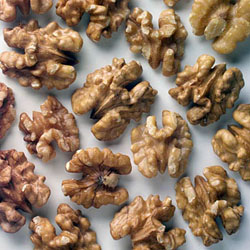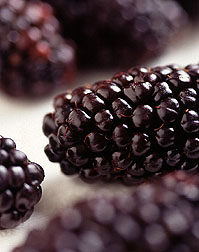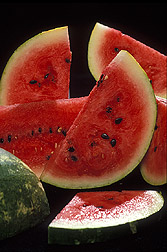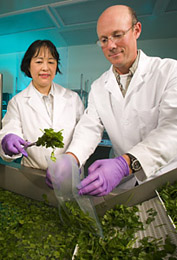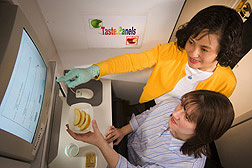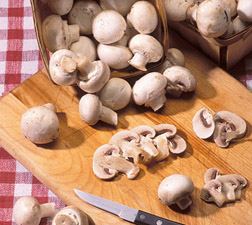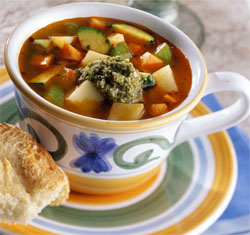| October 2006 |
Walnuts: Potential New Link to Heart Health Uncovered
|
Already shown in some studies to reduce "bad" (LDL) cholesterol, walnuts may have yet another way of enhancing your cardiovascular health.
Tests on 100 laboratory hamsters that ate feed containing ground walnuts for a half-year showed they had significantly lower levels of a protein called endothelin in their arteries. This protein helps regulate blood pressure. But, it also causes inflammation of arteries and growth of sticky deposits, called plaque, in blood vessels. These two conditions contribute to heart disease, the leading cause of death in the United States.
Walnuts suppressed heart artery endothelin when fed at amounts equal to an adult human's eating from three to eight handfuls of walnuts daily (Journal of Nutrition, volume 135, pages 428 to 432). The study was an international collaboration between scientists with ARS, the University of California-Davis and University of Padova (Italy).
Whether this beneficial effect occurs in people at more moderate amounts of walnuts needs further study.
The California Walnut Commission, Sacramento, Calif., helped fund the research.
For details, contact: Wallace H. Yokoyama, (510) 559-5695; USDA-ARS Western Regional Research Center, Albany, Calif.
Blueberries, Strawberries May Forestall Brain Drain
|
Blueberries and strawberries may help slow the decline in learning and memory that often occurs as we age. That's according to new findings from tests with 60 laboratory rats, studied for about three months.
Rats in either of three groups of 20 each ate either a standard feed or feed with blueberry extract equal to that of a daily one-cup portion for humans, or feed with strawberry extract equal to a daily one-pint bowlful.
After two months on the regimens, half of the rats in each group were treated to induce aging. Compared to the aged rats on nonsupplemented feed, the aged-but-supplemented rats performed better in a test of their ability to find, and in some cases remember, a particular feature in their environment.
The new findings add to a series of research studies published during the past eight years showing reduced or reversed declines in brain function among rats whose feed was supplemented with either blueberry, cranberry or strawberry extracts or Concord grape juice.
ARS-funded scientists at the Jean Mayer USDA Human Nutrition Research Center on Aging, Tufts University, Boston, Mass., conducted the research in collaboration with investigators at the University of Maryland-Baltimore County and published their findings in Neurobiology of Aging (online July 13, 2006).
For details, contact: Barbara Shukitt-Hale, (617) 556-3118; ARS Jean Mayer USDA Human Nutrition Research Center on Aging, Boston, Mass.
Compound in Blackberries Studied
|
Fresh blackberries contain a compound that may interfere with genes associated with cancer-promoting agents. The purified compound, cyanidin-3-glucoside (C3G), inhibited growth and spread of skin and lung tumors in tests with laboratory mice (Journal of Biological Chemistry, volume 281, pages 17359 to 17368).
The number and size of skin tumors were significantly reduced among mice that had been supplemented with C3G, when compared to those that had not, the scientists found. In another study, the growth of lung tumors and spread of the cancer to other organs were significantly reduced in immune-system-suppressed mice fed the C3G compound.
Scientists with ARS at Beltsville, Md., and the National Institute for Occupational Safety and Health, Morgantown, W.Va., collaborated in the research.
For details, contact: Shiow Y. Wang, (301) 504-5776, ext. 427; USDA-ARS Henry A. Wallace Beltsville Agricultural Research Center, Beltsville, Md.
Gently Extracting Watermelon's Healthful Lycopene
|
Watermelon, besides being fun to eat, is an excellent source of lycopene--a red-pigmented antioxidant thought to guard against heart disease and some cancers.
Now, an ARS researcher based in Lane, Okla., has developed a new technique that makes it easier to extract lycopene from watermelon flesh and juice.
Users can avoid damaging the fragile membranes of the tiny structures—organelles—that protect the lycopene. This gentle approach yields lycopene that is more stable and thus has a longer shelf life.
Lycopene can be processed into a powder, paste or liquid suitable for use as a nutrition supplement or food coloring.
ARS is seeking a patent for the method, which might also be used to extract lycopene from tomatoes, guava, rose hips and pink grapefruit.
For details, contact: Wayne W. Fish, (580) 889-7395, ext. 261; USDA-ARS South Central Agricultural Research Laboratory, Lane, Okla.
Delving Into Dates' Nutrients, Genetic Diversity
Sweet, chewy dates provide healthful antioxidants—mostly the kind known as phenolics. But the levels of these compounds vary according to what variety of date you're eating, ARS and University of California-Davis scientists have found.
Deglet Noor dates, the leading commercial variety in the United States, logged a higher antioxidant score than five other types of dates grown in California, the nation's leading producer of this exotic crop.
Other ARS-led research yielded new insights into the genetic diversity of date trees safeguarded in a unique collection that ARS curates—the Riverside, Calif.-based National Clonal Germplasm Repository for Citrus and Dates.
For details, contact: Robert R. Krueger, (951) 827-4399; USDA-ARS National Clonal Germplasm Repository for Citrus & Dates, Riverside, Calif.
|
Proper Packaging Helps Produce Breathe, Stay Fresh Longer
You can't hear the fruits and veggies in your refrigerator breathe, but they do. They take in oxygen and give off carbon dioxide. Pairing your fresh produce with a wrapping, or film, best suited to the fruit or veggie's respiratory needs enhances the length of time it will stay fresh and appealing, new tests confirm.
The wraps, newer versions of the familiar, clear-plastic films already used widely in home and commercial kitchens, act as modified-atmosphere packaging that regulates the flow of oxygen and carbon dioxide to and from packages of produce.
While the concept isn't new, ongoing experiments by ARS scientists at Beltsville, Md., provide some of the most up-to-date findings about the unique packaging needs of some half-dozen different fruits and veggies, including baby spinach, carrots, cilantro, iceberg and romaine lettuces and salad savoy—a cabbage relative (Journal of Postharvest Biology and Technology, volume 33, pages 51 to 59).
Experiments with fresh cilantro leaves, for example, showed that one such film can keep this tomato-salsa seasoning fresh for up to 14 days—information useful to produce packers and shippers, as well as film manufacturers.
For details, contact: Yaguang Luo, (301) 504-6186; USDA-ARS Henry A. Wallace Beltsville Agricultural Research Center, Beltsville, Md.
Apple Washes Shield Sliced Fruit From Pathogens
|
Experimental washes, also called antibrowning dips, for freshly sliced apples show promise for keeping the fruit safe to eat, while at the same time protecting its appealing textures, flavors and colors (Food Microbiology, volume 21, pages 319 to 326). Laboratory experiments by ARS researchers based in Beltsville, Md., showed these protective effects in tests with freshly cut apple slices.
Today's calcium-ascorbate-based washes forestall browning but apparently don't knock out as extensive a range of unwanted microbes, according to the Maryland scientists. The newer formulations, not only kept the apple slices from browning, but also killed unwanted microbes.
For details, contact: Arvind A Bhagwat, (301) 504-5106; USDA-ARS Henry A. Wallace Beltsville Agricultural Research Center, Beltsville, Md.
Mushrooms' Newest Nutritional Values Posted to the Web
|
Besides adding their distinctive flavors and textures to salads, soups, burgers—and more—mushrooms also give us key nutrients like copper, potassium, folate and niacin. New nutrient data for seven different kinds of mushrooms—crimini, enoki, maitake, oyster, portabella, shiitake and white button—are now available on the World Wide Web at: www.ars.usda.gov/nutrientdata as part of the USDA National Nutrient Database for Standard Reference, Release 19.
ARS scientists at the Beltsville (Md.) Human Nutrition Research Center led the mushroom-data-gathering project, which was funded in part by the Mushroom Council, Dublin, Calif.
For details, contact: David B. Haytowitz, (301) 504-0714; USDA-ARS Beltsville Human Nutrition Research Center, Beltsville, Md.
Blazer Russet–New Choice for Growers, Potato Lovers
|
Whether sold fresh or processed into frozen potato products, Blazer Russet potato is a top-quality tuber. The oblong, medium-to-large veggie weighs in at about seven to eight ounces and has the characteristic light netting, or russeting, on its brown-to-tan skin, with firm, cream-white or white flesh inside.
ARS scientists at Aberdeen, Idaho, and their University of Idaho, Washington State University and Oregon State University colleagues put the tuber through nearly two decades of rigorous laboratory, field and test-kitchen scrutiny before deciding in December 2005 to make this experimental potato a named variety.
Blazer Russet is ready to harvest at about the same time as the popular, early-maturing Shepody potato. But Blazer provides higher yields of premium, U.S. No. 1 potatoes.
For details, contact: Richard G. Novy, (208) 397-4181, ext. 111; USDA-ARS Small Grains and Potato Germplasm Research Unit, Aberdeen, Idaho.
New "Jeanne" Gooseberries: Delicious—and Pest-Resistant!
|
Summertime treats of tomorrow might include a chilled slice of gooseberry pie, made with a luscious new, dark-red gooseberry called "Jeanne." Scientists with the ARS National Clonal Germplasm Repository, Corvallis, Ore., made the berry available to other researchers and to plant nurseries for the first time this year, following more than 12 years of lab, greenhouse and outdoor tests.
Jeanne gooseberry plants each produce about 3 pounds of sweet, good-sized fruit every year—an impressive harvest that should please commercial growers and backyard gardeners alike.
Jeanne is named for Cheryl Jeanne Gunning, who worked at the Oregon laboratory and is now deceased.
In contrast to most other gooseberries, this plump newcomer is resistant to white pine blister rust, a disease that's a cosmetic problem to gooseberry leaves but can be devastating to pines. The gooseberry also fends off the microbe that causes powdery mildew, the berry's worst disease enemy. What's more, the plant doesn't succumb to attacks by aphids and sawflies.
For details, contact: Kim E. Hummer, (541) 738-4201; USDA-ARS National Clonal Germplasm Repository, Corvallis, Ore.


